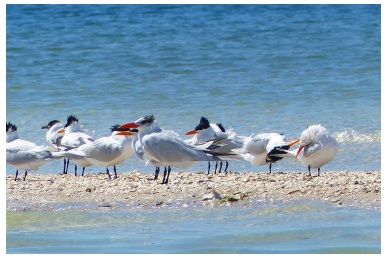Conservation: Tampa Bay
![]() Print this Article | Send to Colleague
Print this Article | Send to Colleague
Port Tampa Bay, Audubon of Florida Announce 2017 Migratory Bird Nesting Season

American Oystercatcher adults stroll along the rocky shoreline of Port Tampa Bay’s Dredge Disposal Island 3D in Hillsborough Bay.
Photo/ Lorraine Margeson, LG2, contractor for U.S. Army Corps of Engineers
Port Tampa Bay (PTB) works very closely with Audubon Florida, as well as state and federal regulatory conservation agencies in Florida, to provide protection annually for nesting birds and their young in the Hillsborough Bay area. The official bird nesting season is April 1 through August 31, each year.
The port owns and operates two dredge disposal islands in Hillsborough Bay – islands 2D and 3D. Both islands and the Richard T. Paul Alafia Bank Bird Sanctuary, have been recognized collectively by BirdLife International and the National Audubon Society for their global significance as bird nesting areas. Protection of the nesting birds that use these islands has evolved into a shared project.
On December 28, 2016, the port issued a letter of support to the Florida Fish and Wildlife Conservation Commission (FWC) for modifying the Critical Wildlife Area (CWA) designation of the Alafia Bank Bird Sanctuary to include the eastern island known as Sunken Island, as approved by the port authority’s board of commissioners. The modified CWA designation includes a 100-foot protection buffer and year-round no entry.
"Port Tampa Bay has earned a leadership role in the management of one of Florida’s most important sites for beach nesting birds," Ann Paul, Audubon Florida’s regional coordinator, said. Mark Rachal, Audubon’s sanctuary manager added, "We are impressed with the port’s commitment to protect birds that nest on the dredge disposal islands and appreciate the opportunity to work with their staff and contractors to achieve better nesting success for some of Florida’s rarest species."
Islands 2D and 3D and the Alafia Bank Bird Sanctuary are designated as "no trespassing" areas year around. Birds that nest in these areas are protected under the Migratory Bird Treaty Act of 1918, as well as the Florida Threatened and Endangered Species Act of 1977.
Port Tampa Bay and Audubon Florida urge cooperation from the boating public in complying with the law and obeying these "no trespassing" designations, to allow nesting migratory birds in Tampa Bay to raise their chicks without disturbance. "Closing these areas year around ensures these birds invaluable protection from significant disturbances during the nesting and migrating seasons," as stated by FWC staff.
"Port Tampa Bay is proud of its long-standing commitment to the health and integrity of natural life in Tampa Bay," said Port President Paul Anderson. "We recognize the continued need to be engaged in partnerships that ensure the quality of our local waters and related habitats."

Caspian Royal Terns congregate at one of Port Tampa Bay’s dredge disposal islands.
Photo/ Lorraine Margeson, LG2, contractor for U.S. Army Corps of Engineers

